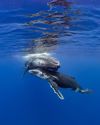Prøve GULL - Gratis
Philippines - The Tattooed Fire Mummies
ASIAN Geographic
|AG 04/2021 - 149
KNOWN BY A host of different names – the Kabayan Mummies, the Ibaloi Mummies or the Benguet Mummies – the Fire Mummies of the Philippines, resting beneath the mountain slopes of Kabayan, are some of the most fascinating mummified remains in the world. Kabayan is one of the municipalities of the province of Benguet in the Cordillera Region of northern Luzon and was home to the Ibaloi, a dominant ethno-linguistic group. Like many tribes in the Cordillera region, the Ibaloi were prolific practitioners of tattooing.

Tourists have access to several of the mummy burial caves in Kabayan
Today, Kabayan is recognised as a centre of Ibaloi culture and the Kabayan Burial Caves, where the mummies are found, are listed as National Cultural Treasures by the National Museum of the Philippines. They are also a part of the Monument Watch’s list of the 100 most endangered sites in the world and have been classified as a UNESCO World Heritage Site.
The mummies are believed to have been created by the Ibaloi people, though the exact time period this was practised remains highly debated. These mummies are unique, not only for their incredible tattoos, but also for the mummification process. The Ibaloi began the process of mummification shortly before the person died by having them ingest a salty concoction. Following the person’s death, the corpse was washed and set over a fire in a seated position in order to dry the fluids. The internal cavities and organs would then be dried by blowing smoke from tobacco into the mouth. Finally, herbs were rubbed into the body before the corpse was placed in a coffin and laid to rest in either rock shelters, natural caves, or man-made burial niches. The mummification process was exclusively used on high ranking individuals in the Ibaloi tribe, though the practice died out in the 1500s after Spain colonised the Philippines.

Denne historien er fra AG 04/2021 - 149-utgaven av ASIAN Geographic.
Abonner på Magzter GOLD for å få tilgang til tusenvis av kuraterte premiumhistorier og over 9000 magasiner og aviser.
Allerede abonnent? Logg på
FLERE HISTORIER FRA ASIAN Geographic

ASIAN Geographic
Cerulean Colossus
A little introduction to the world's biggest fish
6 mins
AG 169

ASIAN Geographic
Tales from the Black Sea
A glimpse of hope
7 mins
AG 169

ASIAN Geographic
The Magnificent Seven
There are seven marine turtle species worldwide, three of which are listed as “Endangered” or “Critically Endangered”. Each have their own habitats, needs and peculiarities, but how much longer will we be able to enjoy their presence on our planet?
4 mins
AG 169
ASIAN Geographic
Ocean Giants
Understanding the enigmatic mantas and other mobula rays
9 mins
AG 169

ASIAN Geographic
10 Top Diving Experiences in the Philippines
The Philippines is renowned worldwide for its breathtaking marine biodiversity, crystal-clear waters, and vibrant coral reefs. Boasting over 7,000 islands, the archipelago offers countless diving spots that cater to beginners and seasoned divers alike. Whether you're seeking thrilling encounters with sharks, exploring world-class wrecks, or immersing yourself in colourful coral gardens, the Philippines has something extraordinary to offer. Here are 10 of the best diving experiences you should add to your bucket list.
1 min
AG 169

ASIAN Geographic
Introducing Hippocampus Unravelling the Seahorse
Seahorses are an elusive species that turn divers giddy with excitement. But what is it about them that fascinates people so much? Quite often, throughout my work and travels, I hear divers say, \"I don't like sharks – they're scary\" or \"Nudibranchs are boring\", but can you ever recall a time when you've heard a diver say that they don't like seahorses? I mean, what is there not to like about this mythical little creature?
3 mins
AG 169

ASIAN Geographic
Go for the Glow
The science behind coral colours
2 mins
AG 169

ASIAN Geographic
Revealed Silver
Known in Latin as argentum, originating from the Sanskrit word argunas meaning \"shining\", silver is often an overlooked metal in comparison to gold, though it has properties that make it a unique and special element.
2 mins
AG 166

ASIAN Geographic
Celebrating the 2023 Rolex Awards for Enterprise Laureate: Liu Shaochuang
As a part of the Perpetual Planet Initiative, the Rolex Awards for Enterprise continues to expand the initiative’s growing portfolio, supporting exceptional individuals with innovative projects in areas such as the environment, science and health, applied technology, cultural heritage, and exploration.
2 mins
AG 166

ASIAN Geographic
The Treasures of Tahiti and the Journey of Giants
For decades, French Polynesia's beguiling islands have adorned travel brochures, alluring honeymooners with turquoise lagoons, overwater bungalows, and lush volcanic peaks. Some 7,000 kilometres from its closest neighbours, and spread over five main island groups, the French territory's real treasures are not just what you see in the splashy brochures. Get ready for untamed, wild, ocean encounters.
6 mins
AG 166
Translate
Change font size

